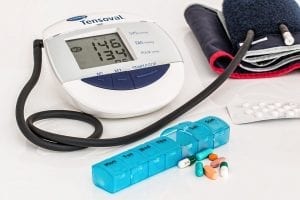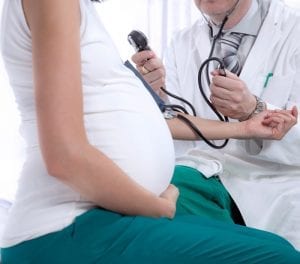Most women are lucky enough to have wonderful, healthy pregnancies from beginning to end. They go through the nine months without any significant complications and deliver their newborn into this world without any difficulty. However, some of us experience mishaps in-between months. As for me, I felt great during my first trimester. I wasn’t nauseated and didn’t have any massive bingeing habits.

In my sixth month, though, I was feeling quite woozy and often vomited. I had pounding headaches, which would just occur suddenly. When I realized that I had gained a lot of weight and my face, feet, and hands were swollen, I knew I had to go to the doctor. That’s when my OB-GYN told me that I had a condition called preeclampsia. But what is preeclampsia’s definition?
What Is Preeclampsia?
The occurrence of hypertension and proteinuria characterizes preeclampsia during pregnancy. Also called pregnancy-induced hypertension or PIH, preeclampsia usually presents on the sixth month to the third trimester of a woman’s pregnancy period, although it may occur earlier. Preeclampsia that is left untreated is a definite risk for developing eclampsia, which is a more dangerous condition that presents with seizures secondary to hypertension. This is potentially fatal and may lead to the death of either the mother or the baby or both.
In rare circumstances, preeclampsia can develop after the mother delivers the baby, and this is called postpartum preeclampsia.
What Causes Preeclampsia?
The exact cause of preeclampsia remains unclear but is believed to be a result of a dysfunctional placenta. Possible causes also include poor nutrition, immune system abnormalities, not enough blood supply going to the uterus, increased body fat, and genetics. Preeclampsia is predominantly seen among first-time mothers, pregnant teens, and pregnant women who are more than 40 years old.
Here is a list of the potential risk factors for pregnant women to develop preeclampsia:

- History of past diagnosis of preeclampsia
- History of hypertension before pregnancy
- Family history (mother or sisters with preeclampsia)
- History of obesity
- History of renal disease, rheumatoid arthritis, or diabetes
- Race (Black women are said to have a higher risk)
- Multiple pregnancies (having twins or triplets)
- Attempting to have a baby through in vitro fertilization
What Are The Signs Of Preeclampsia?
To further discuss the preeclampsia definition, here are the signs. Unfortunately, there have been cases wherein pregnant women don’t experience symptoms before suffering from preeclampsia. Their blood pressure rises slowly or perhaps suddenly. It is, therefore, essential for pregnant women to regularly monitor their blood pressure, as increased blood pressure is usually the first sign of preeclampsia.
Other signs and symptoms that may lead to preeclampsia include but are not limited to:

- Severe headaches
- Visual abnormalities, such as light sensitivity and transient loss of vision
- Increased protein in urine and other renal abnormalities
- Right upper abdominal pain
- Dizziness and vomiting
- Thrombocytopenia (decreased platelet levels)
- Abnormal liver function
- Shortness of breath
Edema and rapid weight gain could be possible symptoms of preeclampsia. However, these symptoms can also be present in women with normal pregnancies, and therefore are not reliable determinants of preeclampsia.
How Can Preeclampsia Be Prevented?

Researchers around the world are continually studying to find ways on how to avoid the occurrence and the complications of preeclampsia but to no avail. The strategies that were previously suggested – exercise, diet, regular intake of garlic, and fish oil – have not shown to decrease the incidence of the condition. There have also been no successful outcomes from regularly taking vitamins E and C. Some studies showed promising results in linking vitamin D supplementation and a decreased risk for preeclampsia, but other studies proved this wrong.
Some pregnant women, however, may experience a decreased risk of preeclampsia by taking low-dose aspirin. Once the doctor sees a good outcome, he recommends the expectant mom to regularly take 81 mg of aspirin after her 12th week of pregnancy.
Calcium supplementation may also help, particularly those who have had previous calcium deficiency and are not getting enough calcium while they are pregnant.
It is imperative, though, that all pregnant women should not take any medications or supplements without informing their primary care physician.
Bottom Line

Since preeclampsia is an inevitable condition in most women who are overweight or have previous hypertension, it is always safe to make sure that you are healthy and fit before planning to get pregnant. If you need to lose weight or exercise to manage your sugar levels, then start doing it now.
Once pregnant, you should take care of yourself by going to your prenatal checkups regularly. This way, your doctor can monitor early signs of preeclampsia. Then both of you can work together on preventing further complications from occurring. This article about preeclampsia definition aims to provide awareness for expectant moms. If you want the best care, you can ask to be referred to a maternal-fetal medicine specialist.
FAQs
How to determine the preeclampsia definition?
It is a condition that makes pregnancy a lot more complicated and challenging. It supports abrupt hypertension, leakage of large amounts of the protein, as well as swelling of some parts such as hands, feet, and face.
What is the first sign of preeclampsia?
The preeclampsia definition and symptoms include swelling, belly pain, high blood pressure, weight gain, and severe headaches (read further here).
Where is preeclampsia pain located?
Usually, it is in the upper-right abdomen, below the ribs. Some instances are often also be felt below the breastbone, a region known as the epigastrium.
How does preeclampsia affect the unborn baby?
Preeclampsia causes smaller or prematurely born babies because it affects the blood flow to the placenta. It can impair kidney and liver function, seizures, and cause blood clotting problems as well.
How do they test for preeclampsia?
Your doctor will order blood, liver function, kidney tests. The professional will also administer a measure of your platelets, urine analysis, and fetal ultrasound.
How early will they induce labor with preeclampsia?
Depending on the cases, time varies. However, hospitals may look to induce labor from 34-37 weeks.
Can stress cause preeclampsia pregnancy?
Yes. Some study shows that high-stress levels, anxiety or depression may somehow directly or indirectly affect pregnancy and lead to preeclampsia.
How early can preeclampsia develop?
Preeclampsia can emerge at any time during pregnancy, delivery, and up to a couple of weeks post-partum.
Can you survive eclampsia?
Cases of eclampsia are rare. Usually, the condition is treatable if appropriate intervention is given. However, in unfortunate instances, the seizures accompany it can result in brain damage, coma, and potentially in maternal or infant death.
How common is eclampsia?
Preeclampsia’s definition serves as the condition common during 1 in every 2,000-3,000 pregnancies.
How does preeclampsia kill you?
If the condition is unfathomable, a pregnant woman may need to deliver the baby early before the fetus is fully grown. It can cause both maternal and infant death. Also, its serious complications, such as seizures, organ damage to the liver and kidneys can cause death too.
Can you see preeclampsia on ultrasound?
Fortunately, yes. Ultrasound Care can now identify women at risk of developing early-onset, severe preeclampsia as early as 12-14 week scan.
Does bed rest help with preeclampsia?
Yes, pregnant women will need strict bed rest. However, if the condition doesn’t improve, she may need to go into the hospital immediately.
How long were you in the hospital with preeclampsia?
Pregnant women with preeclampsia should be kept in the hospital for three days after giving birth.
How do doctors treat preeclampsia?
The best treatment for preeclampsia is delivery (check this page for more information: https://www.medicalnewstoday.com/articles/252025#treatment).
Last Updated on January 12, 2023 by Rejie Salazar
DISCLAIMER (IMPORTANT): This information (including all text, images, audio, or other formats on FamilyHype.com) is not intended to be a substitute for informed professional advice, diagnosis, endorsement or treatment. You should not take any action or avoid taking action without consulting a qualified professional. Always seek the advice of your physician or other qualified health provider with any questions about medical conditions. Do not disregard professional medical advice or delay seeking advice or treatment because of something you have read here a FamilyHype.com.